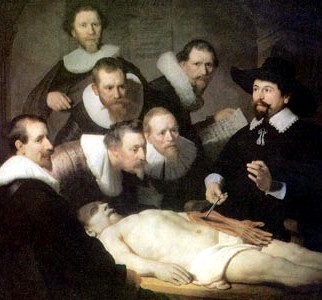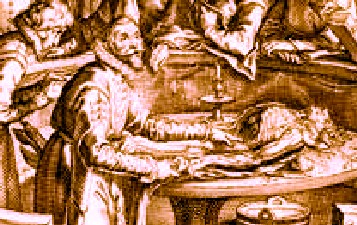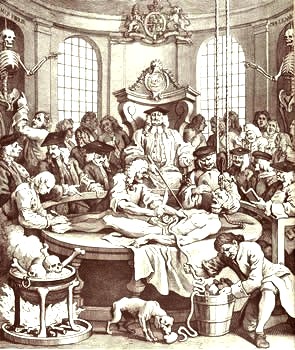
Dealing With the Deceased Menu: 1 2 3 4 5 6 Next>>
Dealing With the Deceased in the Golden Age of Piracy, Page 1
"Chirurgion, look to the wounded, and wind up the slain, with each a weight or Bullet at their Heads and Feet to make them sink, and give them three Guns for their Funerals. Swabber, make clean the Ship, Purser record their Names" (John Smith, Seaman's Grammar and Dictionary, 1691, p. 61)

Photo: Alan Viellier
Dangerouw Jobs: Working on the Upper Topsail
Yard on the Parma(1933)
The sea is an inherently dangerous place to work. Even today, commercial fishing is considered the most dangerous job with a 10 year average of 121 deaths per 100,000 workers. This is followed by loggers (113 deaths per 100,000), flight crews (80), high steel workers (58) and non-fishing maritime workers (46). By comparison, firefighters and police are both around 16 deaths per 100,000.1
Considering all the modern safety precautions required in our age, the death rate of people working sea during the age of sail must have been much higher. David J. Stewart says that the earliest records of death rates for jobs at sea that he could find were in a report made by the Royal Commission on Loss of Life at Sea in 1887. According to that report, the death rate was about 731 per 100,000 sailors.2 Stewart muses, "In earlier centuries, seafaring must have been at least as deadly, if not more so."3 Given that there many documents published by the royal navy that sought to improve safety (among other things) during the Age of Sail before that time, this was almost certainly true.4
Of course, when men died on a ship at sea, something had to be done with them. Dealing with mortality was largely the responsibility of the surgeon. In some cases he would perform an autopsy to determine the cause of death. In most cases he was expected to prepare the body for burial. There is a modern tendency to believe that life was

Artist: Walter Paget
Jim Hawkins Tossing O'Brien Overboard
in Treasure Island (1920)
considered cheap in past centuries, which might suggest that the dead would simply be thrown over the side with minimal ceremony. It is particularly tempting when looking back at criminals such as pirates that they might be particularly callous in their handling of the dead. In Stevenson's 1883 book Treasure Island, the hero Jim Hawkins is confronted with the corpse of O'Brien, who was killed by Israel Hands. He eventually decides to do something with him. "I took him by the waist as if he had been a sack of bran, and, with one good heave, tumbled him overboard."5
However, nothing could be further from the truth in most cases. When pirate François l'Olonnais' buccaneers took fort San Carlos de la Berra near Maracaibo in 1666, "They spent the rest of the day demolishing the fort, burning the gun-carriages, spiking the guns, carrying their wounded on board their ships and burying their dead."6 They even buried the corpses of their enemy. "They gathered the dead to bury them, being above five hundred Spaniards, besides the wounded in the town, and those that died of their wounds in the woods."7 Several accounts of pirates burying their dead with all due ceremony exist, as we shall see.
Bodies of men who died on ships could be buried both on land and at sea. Burial ceremonies existed and were followed in many cases. A corpse had to be properly prepared for burial. Once ready, a rather elaborate procedure was often followed which could include a variety of specific elements such flags, bells, weapons, prayers and sometimes even trumpets. In addition, sailors (and pirates) were concerned about those left behind and sometimes took measures to look after surviving widows and children. A variety of superstitions have been connected with the death of sailors, some of which had roots in this period in history. Let's look at each of these areas of dealing with the deceased during the golden age of piracy.
1 10 Year Trend from 1998-2007, from David J. Stewart, The Sea Their Graves, 2011, p. 6; 2 Based on numbers gathered from 1871 to 1886, from Stewart, p. 7; 3 Stewart, p. 7; 4 For examples, see the multiple editions of Regulations and Instructions Relating to His Majesty's Service at Sea printed between 1731 and 1834 that spell out ways to prevent accidents at sea as well as the various editions of the Purser's Instructions printed between 1735 and 1825 that detail record keeping records for the sick, wounded and deceased as well as the optimal diet for sailors; 5 Robert Louis Stevenson, Treasure Island, p. 163; 6 Alexandre Exquemelin, The Buccaneers of America, 1969 Edition, p. 98; 7 Alexandre Exquemelin, This History of the Buccaneers of America, 1856, p. 76
Autopsy
The sea surgeon was sometimes called upon to perform an autopsy on a deceased crew member. The reason for performing an autopsy seems to have been handled somewhat casually based on the way they are explained in the surgeon's texts. The procedure often simply notes that the corpse was 'opened' to look further into the cause of death. More detail about the reasons for an autopsy are given.

Artist: Rembrandt
The Anatomy Lesson of Dr. Nicolaes Tulp (1632)
Sometimes autopsies were performed to try and find the source of mysterious diseases in a group of men. When treating soldiers suffering from 'a pestilent Dysenterie' at the camp of Amiens in France in 1558, Ambroise Paré decided to perform autopsies to look further into the problem. "I dissecting som of their dead bodies, observed the mouths of the Meseriack [mesenteric] veins and arteries, opened and much swollen; and whereas they entered into the guts [intestines], were just like little Catyledones [cotyledons - glands in the placenta that exchange oxygen and nutrients with the fetal blood in the capillaries], out of which as I pressed them there flowed blood."1
Sea surgeon John Woodall explained that when trying to explain the cause of scurvy "it is manifest that divers [many] of those which have been opened after death, have had their livers utterly rotted."2
A related reason given to perform an autopsy was to satisfy a surgeon's curiosity about a particular case. Paré was attempting to cure a patient who appeared to be suffering from stangury - a painful, frequent need to urinate, even when the bladder is empty - when the patient died. Paré explains "when hee was dead, and his bodie opened, his bladder was found full, and verie much distended with urine, but the prostate preternaturally swelled, ulcerated, and full of matter resembling that which formerly used to run out of his yard [penis], whereby you may gather, that this virulencie flow's from the prostate... and not from the reins [kidneys], as manie have imagined."3 (Clearly prostate cancer was observed at least this long ago.)

Artist: Hieronymus Bosch (14th century)
Sea surgeon John Atkins was asked to advise in the case of a boy who fell from the main yard who appeared to have a fractured skull. The boy died following an unsuccessful trepanation. "On opening the Skull, the Fracture was found to be the whole Length of the Occipital Bone; and inside the Membranes abundance of fœtid Matter."4
Atkins was also brought in for a case of a Mr. Booth, who was suffering from intermittent fever (probably malaria). Physician Thomas Dover had prescribed mercury, which caused the patient headaches and pain in the bowels. Physician Hans Sloan was brought in and, on learning that "he voided none of the Mercury", Sloan tried purging the man with enemas. The man died. Atkins explains, "On opening his Body, and ripping up the Rectum and the other Intestines with a Pair of Scissars, there was found little Excrement, but the whole inside Track lined with Crude Mercury, divided in Globules the Bigness of a Pins-Heads: The Rectum broke like Tinder, and sent forth a most cadaverous Stench. The others were not glazed over with mercury, as has been said; for they were as black as your Hat, and so rotten, they would not endure the least straining without breaking in Pieces."5

Artist: Andreas Stock -
An Anatomical Theater (1616)
Sometimes the decedent themselves asked to be autopsied after death. Privateer William Dampier reveals, "While here [Pulo Condore off Vietnam] two of our Men died, who were poisoned at Mindanao, they told us of it when they found themselves poisoned, and had lingered ever since. They were open’d by our Doctor according to their own Request before they died, and their Livers were black, light and dry, like Pieces of Cork."6
Seaman Nicholas Told says that the captain of his ship was poisoned and "strictly charged the surgeon to open him when dead, for the satisfaction of his wife. He soon after made his exit, and upon his body's dissection, the surgeon pointed out to us the mystery of the poison, and its operation; likewise the cause of his voiding such quantities of blood, which was in consequence of the veins across his stomach being cut by the poison, into five hundred pieces."7
1 Ambroise Paré, The Workes of that Famous Chirurgion Ambrose Parey, 1649, p. 572; 2 John Woodall, the surgions mate, 1617, p. 182; 3 Paré, p. 477; 4 John Atkins, The Navy Surgeon, p. 91; 5 Atkins, p. 259-60; 6 William Dampier, Memoirs of a Buccaneer, Dampier’s New Voyage Round the World -1697-, p. 270; 7 Silas Told, An Account of the Life, and Dealings of God with Silas Told &c., 1786, p. 30
Autopsy Procedure
Autopsies were sometimes regarded with distrust, being pictured as irreverent and callous operations as evidenced in scathing indictments of human body dissection in artwork such as William Hogath's

Artist: William Hogarth
The Rewards of Cruelty
(1751)
1751 picture "The Rewards of Cruelty". Yet a well-planned autopsy procedure was detailed by French surgeon Ambroise Paré in the late 16th century. He provides instructions to the surgeon for "making and framing his Report, or opinion... of the death of anie person"1. Paré does recognize the limitations of such reporting, warning that "the events of diseases are often-times doubtful and uncertain, neither can anie man fore-tel them certainly, whether they will bee for life or death, by reason of the manifold nature of the subject of which wee speak, and also the uncertain condition of the humors both in their kinde and motion."2
In indicating causes of death, Paré divides 'great' wounds into three types including those that cause catastrophic damage to the body, small wounds that damage body parts "whose action and function is necessarie: to preserv life" (such as the brain, lungs and liver), and wounds which produce an excess of bad humors that can debilitate the body.3 He then provides a list of of various body parts and how they will appear or behave when they are the potential cause of death.4
Of interest are Paré's comments on extraordinary tragedies. He explains that understanding such things is important because officials may ask the surgeon to determine if they are truly the cause of death. For example, he notes that "Lightning doth always leav som impression or sign of som fire either by ustion [burning] or blackness: for no lighning is without fire."5
For drowning victims, he explains the difference between a true drowning and someone who has been thrown in the water after death:

The Wizened Ambroise Paré
Whosoever is found dead in the waters, you shall know whether they were thrown into the the water alive or dead. For all the bellie of him that was thown in alive, will bee swoln and puffed up by reason of the water that is conteined therein; certain clammie excrements com out at his mouth and nostrils, the ends of his fingers will bee worn and excoriated, becaus that hee died striving and digging or scraping in the sand or bottom of the river, seeking somwhat Whereon hee might take hold to save himself from drowning.6
Related to that is a discussion of determining when wounds were received.
Truly the wounds that are made of a living man, if hee die of them, after his death will appear red and bloodie, with the sides or edges swoln, or pale round about: contrariwise, those that are made in a dead man, will bee neither red, bloodie, swoln, nor puffed up. For all the faculties and functions of life in the bodie do ceas and fall together by death; so that thenceforth no spirits nor blood can bee sent, or flow into the wounded place.7
Such explanations would readily fit into the plot of a modern-day crime procedural.
1,2,3 Ambroise Paré, The Workes of that Famous Chirurgion Ambrose Parey, 1649, p. 753; 4 Paré, p. 753-4; 5 Paré, p. 755; 6 Paré, p. 756; 7 Paré, p. 755

